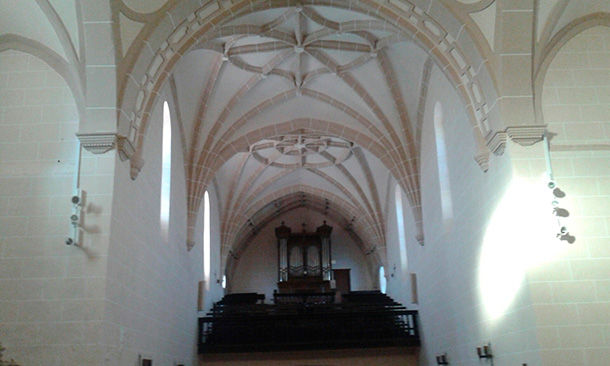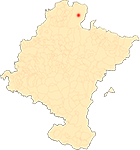Renaissance churches in the Baztan valley
By María Josefa Tarifa Castilla
Church of the Assumption of Amaiur
The church of the Assumption of Amaiur was a medieval temple that underwent a major reform in the second half of the 16th century in the space of the chancel by the master stonemason Martín de Amasa, a resident of Doneztebe/Santesteban, from 1556, an intervention that has not survived to the present day as it was replaced by the extension that the building underwent in the 18th century. On the other hand, the other modification that the building underwent in the 15th century by the stonemason Juan Martínez de Leizagoyen, who built the nave that was to be attached to the aforementioned Renaissance chancel, a work that was completed by the stonemason Juan de Goyarán, a native of Erratzu, has been preserved.
As result of the different construction phases that took place over time, the church currently has a Latin cross floor plan, with a straight chancel, Wayside Cross and a Baroque-style sacristy, followed by a narrow, high Renaissance nave divided into three bays separated by pointed moulded arches resting on corbels, with a high 18th century choir at the foot of the church. The characteristic star-shaped ribbed vaults, so common in 16th century Navarre, overhang the plastered walls of the nave of the church, covering the lower section with a reticulated pointed vault, while in the second and third sections star-shaped vaults are used with moulded ribs forming a triplet or four-pointed star, to which curved ribs are superimposed around the core topic polar.
The exterior of the building, whose partially plastered walls conceal the rows of pinkish stone built at the end of the 16th century, shows a marked tendency towards horizontality, counteracted by the tower attached to the gable wall, whose 16th century cubic shaft is topped by an octagonal bell tower contracted in 1773 by the stonemason Pedro José de Iriarte and the carpenter Pedro de Errazu.
ECHEVERRÍA GOÑI, P. L. and FERNÁNDEZ GRACIA, R., "Arquitectura religiosa de los siglos XVI al XVIII en Navarra", in Ibaiak eta Haranak, Guía del patrimonio histórico-artístico-paisajístico, t. 8, San Sebastián, Etor, 1991, pp. 175-216.
FERNÁNDEZ GRACIA, R., (coord.), ECHEVERRÍA GOÑI, P. L. Y GARCÍA GAINZA, M. C., El arte del Renacimiento en Navarra, Pamplona, Gobierno de Navarra, 2005.
GARCÍA GAINZA, M. C., ORBE SIVATTE, M., DOMEÑO MARTÍNEZ DE MORENTIN, A. and AZANZA LÓPEZ, J. J., Catalog Monumental de Navarra, V*. Merindad de Pamplona, Pamplona, Institución Príncipe de Viana, 1994, pp. 285-422.
OMEÑACA SANZ, J. M., "La iglesia parroquial de Ciga en el Baztan", Scripta Theologica, t. 16, 1984 / 1-2, pp. 543-552.
TARIFA CASTILLA, M. J., "The shell churches of the Renaissance in Baztan. Cuadernos de Artes Plásticas y Monumentales, San Sebastián, Sociedad de Estudios Vascos, 2009, pp. 333-405.











